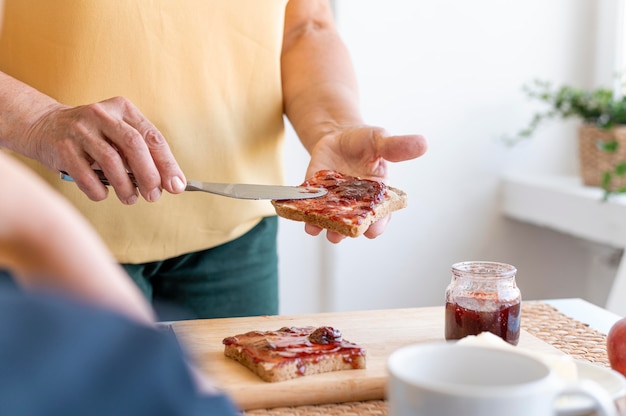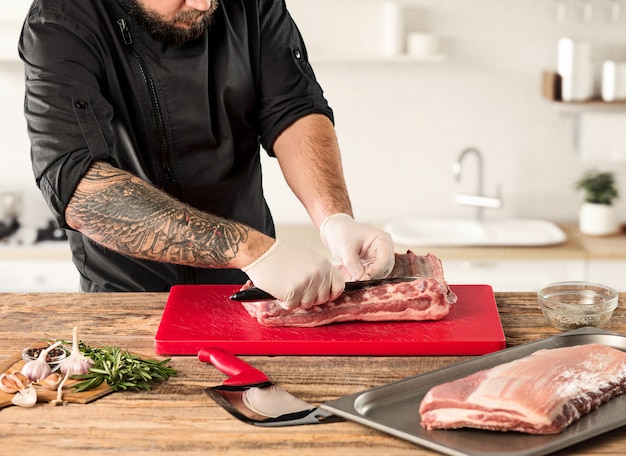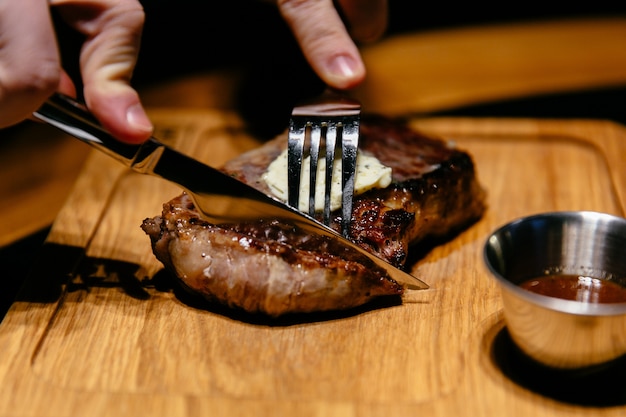Let’s be real, a flawlessly cooked Porterhouse steak is the ultimate culinary triumph. It’s a feast for the eyes, a symphony of textures, and a true taste sensation. But achieving that perfect balance of tenderness, juiciness, and flavour can seem like a daunting task.
Fear not, my friend! I’ve been grilling, pan-frying, and oven-baking Porterhouses for years, and I’ve picked up a few tricks along the way. This comprehensive guide will lead you from novice to steak master, ensuring you create a masterpiece that will leave everyone speechless.
(Part 1) The Foundation: Choosing Your Perfect Porterhouse

The Cut: A Tale of Two Steaks
First things first, you need to choose your canvas – the star of the show – the Porterhouse itself. A true Porterhouse is a hefty cut of beef boasting a T-bone, a natural divider between two distinct yet equally delicious steaks:
The filet mignon: This tender, delicate half is the epitome of buttery, melt-in-your-mouth indulgence.
The new york strip: This side packs a punch with its rich, robust flavour and a satisfyingly chewy texture.
The ideal Porterhouse should be at least 1.5 inches thick, ensuring you have ample room for a beautiful sear. This thickness allows the marbling, the fat that gives the steak its incredible flavour, to render evenly and create a juicy, flavourful experience.
The Marbling: Fat is Your Friend
Speaking of marbling, it's the white fat interwoven throughout the meat. Think of it as the secret ingredient that makes the steak sing. The more marbling, the richer the flavour. Look for a steak with beautiful, even marbling, but avoid excessive fat content, as it can make the steak overly greasy.
The Quality: Investing in Excellence
Finally, you want to choose a steak of exceptional quality. In the UK, look for steaks graded by the British Meat and Livestock Commission (EBLC). Opt for a 'Prime' or 'Matured' steak, signifying the highest quality. In the US, the USDA grading system offers the 'Prime' grade, a mark of premium quality. Both 'Prime' and 'Matured' steaks ensure tenderness, juiciness, and an explosion of flavour.
(Part 2) The Stage is Set: Getting Your Steak Ready

Bringing the Steak to Room Temperature: A Matter of Patience
Once you’ve got your prized Porterhouse, it’s time to prepare it for its starring role. Resist the urge to rush it straight onto the hot pan. Instead, take it out of the fridge and let it rest at room temperature for about 30 minutes. This gentle transition allows the steak to come to a consistent temperature, ensuring even cooking and preventing a shock that can lead to uneven cooking and a less-than-desirable texture.
Seasoning: A Touch of Salt, a Whisper of Spice
Now, for the seasoning. Salt is your most trusted companion. Its magic lies in its ability to draw out moisture and flavour from the steak, resulting in a delectable crust. While some prefer the simplicity of salt and pepper, feel free to unleash your creativity. A sprinkle of garlic powder, paprika, or even a touch of onion powder can add layers of complexity. Remember, less is more; let the natural flavour of the steak shine through.
Washing the Steak? Absolutely Not!
A common misconception is that washing a steak before cooking will remove bacteria. However, washing actually washes away the natural juices and flavour that make the steak so delicious. Think of it as a steak's personality! Leave it untouched, and let its natural goodness shine.
(Part 3) The Dramatic Entrance: Achieving the perfect sear

The Heat: Blazing Hot, Not Tepid
Here's where the excitement begins. You need a pan or grill that's screaming hot. Don’t shy away from cranking up the heat! A cast iron pan is a real game-changer for achieving that impeccable sear. The thick, heavy base retains heat beautifully, resulting in a perfectly caramelized crust. A hot grill, however, also delivers a wonderful smoky flavour.
The Technique: A Gentle Dance with Heat
Place your steak on the pan or grill, ensuring there's enough space for it to breathe. Overcrowding the pan will prevent a proper sear, so give your steak some room to shine. Let it cook undisturbed for about 2-3 minutes per side. This is where the magic happens, creating that coveted crispy crust that locks in the juicy flavour within.
The Flip: Resist the Urge to Overflip
Once the first side is beautifully seared, flip the steak over and repeat the process. This is the point where patience is crucial. Resist the urge to constantly flip it back and forth. Flipping too often will prevent the steak from forming a gorgeous, even crust and could even lead to a dry, chewy texture.
(Part 4) The Grand Finale: Cooking to Perfection
Checking the Doneness: The Art of Touch and Temperature
Now it’s time to bring your steak to its desired level of doneness. While personal preference reigns supreme, I personally favour medium-rare, a beautiful balance of tenderness and a hint of pink at the centre. But whether you lean towards a rare, medium, or well-done steak, the key is to cook it with precision.
The Thermometer: Your Steak's Best Friend
To ensure accuracy and avoid overcooking, a meat thermometer is your trusty sidekick. It takes the guesswork out of the process and allows you to achieve the perfect doneness every time. Here's a handy guide to the different levels of doneness:
| Doneness | internal temperature (°F) | Internal Temperature (°C) |
|---|---|---|
| Rare | 125-130 | 52-54 |
| Medium-Rare | 130-135 | 54-57 |
| Medium | 135-140 | 57-60 |
| Medium-Well | 140-145 | 60-63 |
| Well-Done | 145-150 | 63-66 |
Resting Time: A Moment of Relaxation
Once the steak reaches its desired doneness, remove it from the heat and let it rest for about 5-10 minutes. This step is often overlooked, but it's crucial for achieving a succulent, flavourful steak. During the resting period, the juices redistribute throughout the meat, resulting in a more tender and flavourful bite. Resist the temptation to cut into the steak immediately – it's worth the wait!
(Part 5) The Finishing Touches: A Touch of Elegance
Garnishing: Simplicity and Sophistication
Your steak is now cooked to perfection, ready for its final moments of glory. I believe in the power of simplicity. A knob of butter, a sprig of rosemary, a sprinkle of sea salt and pepper – these simple touches elevate the steak's flavour and aroma to new heights. However, feel free to unleash your creativity. A drizzle of balsamic glaze, a splash of red wine sauce, or a pinch of fresh herbs can add a touch of sophistication and complexity.
The Sides: Complementary Companions
A steak deserves the best supporting cast. I personally favour classic mashed potatoes, a medley of roasted vegetables, or a crisp green salad. But the possibilities are endless! Explore your culinary preferences and select the sides that best complement your masterpiece.
Serving: A Symphony of Texture
Finally, it's time to unveil your culinary triumph. Slice the steak across the grain, cutting through the muscle fibres. This technique ensures a tender, satisfying bite, revealing the beautiful marbling within.
(Part 6) Exploring the Methods: Choosing the Right Approach
The Grill: Embracing the Smoky Aroma
There's nothing quite like the smoky aroma and charred crust that only grilling can deliver. However, ensure your grill is blazing hot, as low heat won't give you that impressive sear.
The Pan: Quick, Easy, and Delicious
For a quick and easy method, a cast iron pan is a true friend. It delivers that stunning sear, allowing you to control the heat precisely. Adding a touch of butter or oil to the pan not only adds flavour but also prevents the steak from sticking.
The Oven: Hands-Off Precision
If you prefer a more hands-off approach, the oven is a reliable option. Preheat your oven to 400°F (200°C) and cook the steak for 10-12 minutes for medium-rare. This is particularly useful for larger steaks or when cooking multiple steaks at once.
(Part 7) A Touch of Culinary Rescue: Fixing Overcooked or Undercooked Steaks
Overcooked Steak: A Delicious Redemption
It happens to the best of us. We get caught up in the excitement and accidentally overcook our steak. Don't despair! It's not the end of the world. The best remedy is to slice the overcooked steak thinly and serve it with a rich sauce, such as a creamy mushroom sauce or a bold chimichurri. The sauce will help to mask the dryness and add moisture, making it a delightful dish.
Undercooked Steak: A Quick Fix
On the other hand, if your steak is undercooked, you can simply cook it for a few more minutes until it reaches your desired doneness. Just be sure to keep a watchful eye on it to avoid overcooking.
(Part 8) FAQs: Addressing Your Steak-Related Queries
1. How long should I cook a Porterhouse steak?
The cooking time depends on the steak's thickness and your desired level of doneness. A 1.5-inch thick steak cooked to medium-rare will take approximately 10-12 minutes.
2. What temperature should I cook a Porterhouse steak to?
For medium-rare, the ideal internal temperature is 130-135°F (54-57°C). A meat thermometer is your best friend for ensuring accuracy.
3. How can I tell if a Porterhouse steak is cooked?
You can use a meat thermometer for the most accurate reading. Alternatively, the touch method can give you an indication. A medium-rare steak will feel firm to the touch.
4. Can I cook a Porterhouse steak in the oven?
Yes, the oven is a reliable option. Preheat your oven to 400°F (200°C) and cook the steak for 10-12 minutes for medium-rare.
5. What is the best way to serve a Porterhouse steak?
Serving a Porterhouse steak sliced across the grain enhances its tenderness. A simple garnish of butter, rosemary, or a drizzle of balsamic glaze adds a touch of elegance and flavour.
Everyone is watching

Corn on the Cob: The Ultimate Guide to Perfectly Cooked Ears
Healthy MealsAh, corn on the cob. Just the name evokes images of sunny days, barbecues, and that sweet, juicy flavour that ...

Scallops: The Ultimate Guide to Perfect Cooking
Healthy MealsAh, scallops. Those delicate, sweet, and utterly delicious morsels of the sea. They hold a special place in my...

Spaghetti Squash: The Ultimate Guide to Cooking and Serving
Healthy MealsRemember that time you saw spaghetti squash at the supermarket, looking all bumpy and strange, and thought, "W...

Salmon Cooking Times: Perfect Guide for Every Recipe
Healthy MealsLet me tell you, cooking salmon is an art form. It's all about getting that perfect balance: juicy and tender,...

Ham Cooking Time: How Long to Bake, Smoke, or Boil a Delicious Ham
Healthy MealsAh, ham. It's a classic, isn't it? A real crowd-pleaser, especially around holidays. And when done right, it'...
